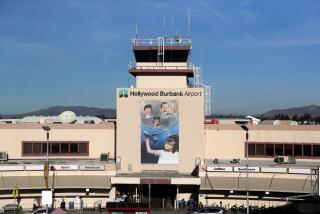Airport Curfew Should Seek a Middle Ground : Policy must include options to appease carriers and neighbors
- Share via
The Burbank-Glendale-Pasadena Airport has a mandatory curfew on freight carrier flights, some general aviation planes, and older jets operating between 10 p.m. and 7 a.m. But commercial jets only are subject to a voluntary curfew during those hours. Now the Burbank City Council, and some others, want that changed. Burbank has even taken a further step: no new terminal and no new gates until a curfew with teeth is obtained.
The council wants one that would prevent the arrival of seven commercial jets after 10 p.m. every weekday, and six others that depart before 7 a.m. That seems like something to cheer about for neighbors weary of noise.
Well, it might be simple if noise was the only consideration. Southwest and United Airlines and others could simply shift to earlier arrivals and later departures. Instead, they are driven by the essence of capitalism: supply and demand.
As long as passengers demand service beyond curfew hours, the airlines will try to supply it. When demand dissipates, so will the flights. Of course, carriers would be compelled to follow a mandatory curfew approved by the Federal Aviation Administration, but local rules might cause repercussions.
Is the city willing to risk losing air carriers who might find stronger curfews restrictive? Would it be easy to attract other airlines to maintain the vast fiscal benefits that accrue from a thriving airport? Would a new curfew affect the willingness of businesses to locate near the airport? Is it worth the trade-off?
And there are all sorts of curfews and various exemptions, such as for emergencies. It would be best to consider a range of options that would be palatable to neighbors as well as the airlines. By this we mean curfews based on decibel levels, or curfews on departures, not on arrivals. We mean adjusted curfew hours that might offer neighbors relief without affecting an air carrier’s bottom line.
Yes, federal aviation law governing airport improvements places noise factors second only to matters involving safe flight operations. Federal law says that it is in the public interest to give noise mitigation efforts a high priority, and that noise management is “crucial” to a continued increase in airport capacity.
But in considering whether to approve a curfew, the FAA is directed by larger concerns, such as an overall federal policy which states that artificial restrictions on airport capacity are not in the public interest and should not discriminate unjustly between categories and classes of aircraft. Such restriction must also be “reasonable” and “non-arbitrary.”
Other factors: Would a mandatory curfew place an unreasonable burden on interstate or foreign commerce? National aviation noise policy also refers to the fact that community noise concerns have led to uncoordinated and inconsistent restrictions on aviation that could impede the national air transportation system.
And even if an agreement is later reached that seems to satisfy all parties, there are no guarantees.
On Jan. 26, 1984, for example, a Times headline said, “Noise Plan Ends Sky War at Santa Monica Airport.” The plan reduced noise levels, stopped lawsuits, shifted most operations from one side of the airport to the other, and allowed the city to impose penalties and banish offending pilots. It gained the backing of the FAA, the Santa Monica City Council, pilots and neighbors.
Today, you would be hard-pressed to find any close-in neighbor who isn’t just as aggravated about airport traffic and noise as their predecessors were back in 1984.
At Burbank, even a curfew soft enough for federal mandates could add a little extra quiet time to the beginning and end of the day, at some potential cost to the local economy. That’s how this curfew ought to be advertised.
More to Read
Sign up for The Wild
We’ll help you find the best places to hike, bike and run, as well as the perfect silent spots for meditation and yoga.
You may occasionally receive promotional content from the Los Angeles Times.






